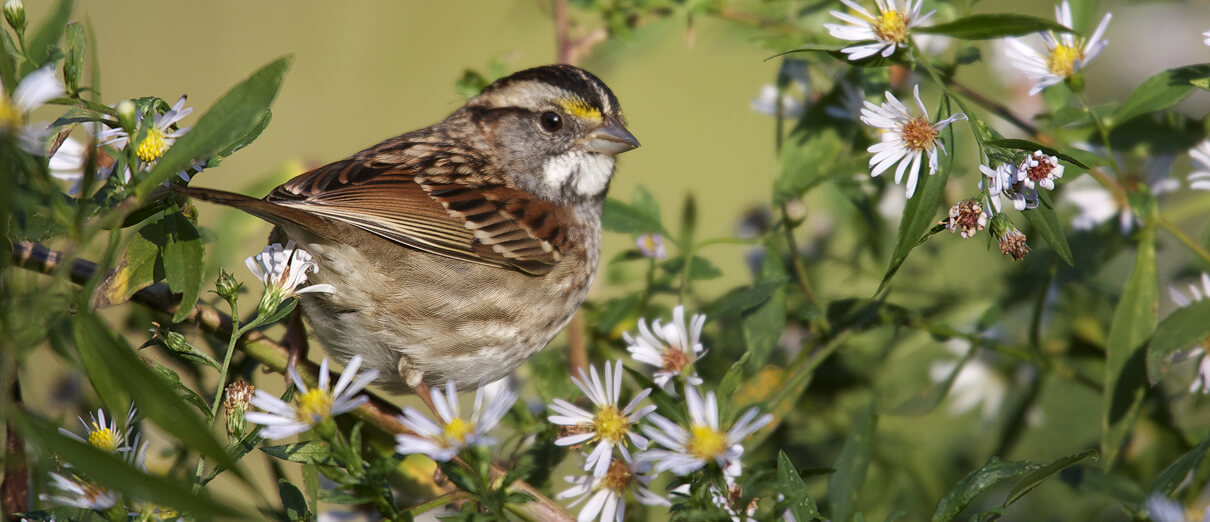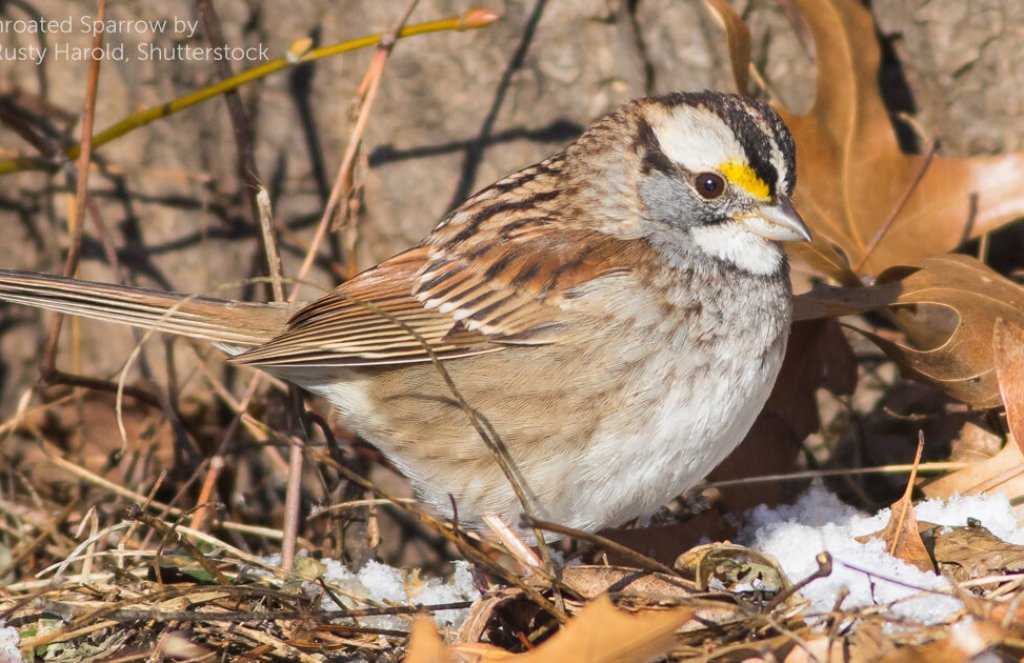
White-throated Sparrow range map by ABC.
White-throated Sparrows are a familiar sight in backyards and around bird feeders across the eastern United States from late fall to mid-spring. Adults have yellow lores, striped crowns, and, as you'd expect, whitish or white throats. At bird feeders, you're likely to see them defer to larger birds, such as Blue Jays, Northern Cardinals, and Eastern Towhees, but to displace chickadees. They can often be seen shuffling in leaf litter near Song Sparrows and Dark-eyed Juncos.
White-throated Sparrows come in two color forms that differ in head color: white-striped and tan-striped birds. The distinct plumages are not related to age or gender, as is the case with many bird species.
One Species, Two Morphs
Adult White-throated Sparrows are polymorphic, occurring in two plumage types, or forms: white striped (bright) or tan striped (dull). On white-striped individuals, the supercilium (eyebrow) and central crown stripe are white; these areas are tan in tan-striped individuals. White-striped birds are also much grayer, with a more clearly defined white throat.
Male and female White-throated Sparrows can be either bright or dull, and equal numbers of both morphs occur. Interestingly, opposites attract: Bright females tend to mate with dull males, and vice versa. White-striped individuals, both male and female, are more aggressive than tan-striped birds, but those of the dull morph are more attentive to their offspring, so it's a complementary pairing.
Singing a Different Song
Many North American birders are familiar with the distinctive and memorable song of the White-throated Sparrow: “Old Sam Peabody Peabody Peabody,” or “Oh, Sweet Canada, Canada, Canada,” but that song is evolving before our very ears. An abridged version of the repeated triplet (“Peabody” or “Canada”) emerged west of the Canadian Rockies about two decades ago. Today, that vocal trend has spread to White-throated Sparrow populations across many parts of the continent. If you live within this species' wintering, migration, or breeding ranges, keep your ears tuned to hear “Old Sam Peabod Peabod Peabod,” or an even shorter version: “Oh Sweet Can.” Also listen for its sharp call note, which sounds similar to that of the Northern Cardinal.
Listen here:
(Audio: Martin St-Michel, XC467709. Accessible at www.xeno-canto.org/467709 · Ray Cooke, XC566110. Accessible at www.xeno-canto.org/566110 · Christopher McPherson, XC600075. Accessible at www.xeno-canto.org/600075)
A North American Original
Endemic to North America, this distinctive sparrow breeds in coniferous and mixed forests across much of Canada, throughout New England, and as far south as northern Pennsylvania, as well as in the northern Great Lakes region. It winters from southeastern Arizona to Nova Scotia and south into central Florida, with a small population along the Pacific Coast. Some individuals show up in far northern Mexico, just south of the U.S. border. In winter, the White-throated Sparrow population is most dense in the East, especially the Southeast, but during migration, the species regularly turns up in the Great Plains.
Reaching for a Bud … or a Seed or an Insect …
The White-throated Sparrow eats small seeds and fruit, buds, and, when available, insects. It forages primarily on the ground, but also in small bushes or along the lower branches of evergreen trees. On the ground, watch for its rapid, double-footed kick, used to move aside leaf litter as it scratches for seeds. It pounces on crawling insects but can also snag flying insects. Its favorite seed at feeding stations is millet, but it will eat black oil sunflower and other seeds.
The Business of Nesting
Socially monogamous, the White-throated Sparrow's pair bond usually lasts through the breeding season, but not necessarily between years. Male White-throated Sparrows return to their breeding range to establish nesting territories one or two weeks before females arrive. Pairs form quickly, and the male and female frequently forage together. The female alone builds the open, cup-shaped nest, which she places on or near the ground and concealed by vegetation, usually along a thicket edge. Nesting materials include grasses, twigs, pine needles, wood chips, and deer fur.

An individual of the White-throated Sparrow's tan-striped form, in Central Park, New York City. Photo @Michael Stubblefield.
On average, a female lays four pale-blue or greenish-blue eggs that are speckled with purple or chestnut. She incubates her eggs for around 12 days. Both parents feed the young birds, which leave the nest seven to 12 days after hatching. After fledging, these “youngsters” still depend on their parents for an additional two weeks or so. From time to time, White-throated Sparrows mate with Dark-eyed Juncos, with the resulting offspring resembling extra-gray White-throated Sparrows. A hybrid's song combines the trill of a junco with the triplet of a White-throated Sparrow.
Familiar, and Fewer
Although the White-throated Sparrow is relatively common, the conservation consortium Partners in Flight ranks it as in decline, with its population dipping an estimated 29 percent between 1970 and 2014. This songbird is one of the most frequent victims of window collisions, according to urban bird-monitoring programs around the country. ABC's Collisions Program is working to increase awareness of this problem and offer solutions that will keep even our most common birds safer.
Donate to support ABC's conservation mission!



















































